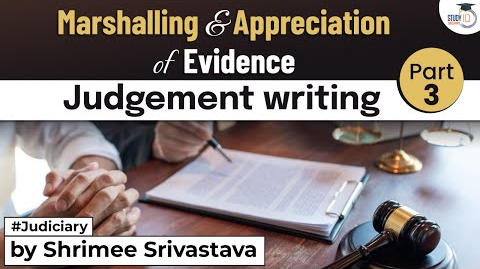Table of Contents
Marshalling and Appreciation of Evidence
MARSHALLING OF EVIDENCE
- Marshalling of evidence means arranging the evidence of the parties.
- Sequencing of the evidence which leads to the proper appreciation of evidence by the court.
- Good marshalling of evidence is a pre-condition to good appreciation of the evidence.
Steps for proper marshalling of evidence
- Examine all the evidence whether oral or documentary as produced by the parties.
- After that arrange all the connected evidence together under the analysis of an issue or point of determination.
- The complete testimony of any witness is not to be stated under one issue and you have to pick only those statements from the larger testimony of the witness which are helpful in proving the particular fact in issue.
Appreciation of Evidence
- Appreciation of evidence basically means weighing the reliability and trustworthiness of the evidence adduced in a case.
- Under section 3 of the Indian Evidence Act, 1872 ‘evidence’ means and includes all statements, which the court permits or requires to be made before it by witnesses (oral evidence), in relation to matters of fact under enquiry and all documents including electronic records produced for the inspection of the court (documentary evidence).
- Section 5 of Indian Evidence Act, 1872, provides that a party can give the evidence to prove only the Fact in issue or relevant fact and no evidence can be given regarding any other fact.
- Also as per section 136 paragraph 1 of the Indian Evidence Act, 1872, whenever any party wants to produce any evidence to prove any fact, the court may first ask the party to prove how that fact is relevant as per the Evidence Act (section 6-55).
- So while appreciating the evidence, first thing you have to do is to establish the relevancy of the facts under sections 6 to 55 of the Evidence Act.
- Another point is that the facts which are proved by the party with the help of trustworthy evidence, only those facts are taken into consideration by the court to decide the case.
- The following steps for appreciation of evidence-
- Step 1: Establish relevancy of evidence – first prove that given fact is relevant under the IEA,1872
- Step 2: Admissibility of evidence – the next step is to lead the evidence on facts proved to be relevant so as to prove the fact itself.
- Step 3: Appreciation of evidence – appreciation of the evidence produced on relevant fact is done to check reliability of the evidence.
- Step 4: If evidence is reliable then it will prove the relevant fact or fact in issue and this is the stage when the fact is said to be duly proved.
- Step 5: last step is to write decision on the basis of those relevant facts duly proved.
Download | Free PDF






















 WhatsApp
WhatsApp